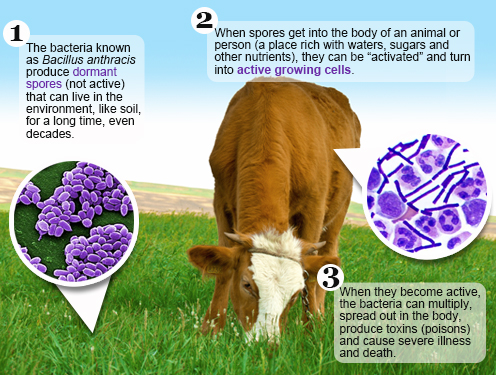- Home
- Prelims
- Mains
- Current Affairs
- Study Materials
- Test Series
What is Anthrax?
After finding several carcasses of wild boar, Kerala health officials on 30 June 2022confirmed the presence of anthrax, a serious infectious disease caused by spore-forming bacteria, in Athirappilly of Thrissur district.
Health Minister Veena George confirmed the outbreak and said the government was taking immediate steps to prevent the spread of the disease.
Anthrax has usually been found in India’s southern states and is less frequently found in the northern states. Over the past years, it has been reported in Andhra Pradesh, Jammu and Kashmir, Tamil Nadu, Assam, Orissa and Karnataka.
What is Anthrax?
Anthrax, also known as malignant pustule or woolsorter’s disease, is a rare but serious disease caused by the rod-shaped bacteria known as Bacillus anthracis. It occurs naturally in soil and, according to the WHO it is primarily a disease of herbivores, with both domestic and wild animals being affected by it.
Anthrax is a zoonotic disease, meaning that it is naturally transmissible from animals (usually vertebrae) to humans. People can get the disease through contact with infected animals or animal products that are contaminated with bacteria.
According to the WHO, Anthrax is generally regarded as non-contagious. There have been instances of person-to-person transmission however, such instances are extremely rare.

How do animals get Anthrax?
Domestic and wild animals can get infected when they breathe in or ingest spores in contaminated soil, plants or water.
Host animals shed the bacteria into the ground, which sporulates when exposed to the air. These spores, which can persist in the soil for decades, wait to be taken up by another host, subsequently germinating and multiplying, leading to its spread. Flies also appear to play a significant role in explosive outbreaks of the disease, as per the WHO.
Herbivorous animals can get the disease through contaminated soil and feed, while omnivorous and carnivorous animals get infected through contaminated meat, bones and other feeds. Wild animals get sick through feeding on anthrax-infected carcasses, according to the Ministry of Health and Family Welfare’s National Health Portal.
How do humans get infected?
Humans almost always contract the disease directly or indirectly from animals or animal products.
People get infected with anthrax when spores enter the body, through breathing, eating contaminated food or drinking contaminated water, or through cuts or scrapes in the skin. The spores then get “activated” and multiply, spreading across the body, producing toxins and causing severe illness, according to the Centres for Disease Control and Prevention (CDC), The US’s national public health agency.
Humans can acquire the disease by handling carcasses, bones, wool, hides or other products from infected animals. People that deal with animals can get cutaneous anthrax when spores from the enter through cuts or scrapes on the skin. They can also get inhalation anthrax, by inhaling spores present on the wool, hide or hair of the animal. Ingesting raw or undercooked meat from infected animals can get people sick with gastrointestinal anthrax.
People that are most at risk of contracting the disease are people that work with animals, such as farmers, veterinarians, livestock handlers, wool sorters and laboratory professionals, according to the National Health Portal.
What are the symptoms of Anthrax?
In livestock species, like cattle, sheep or goats, the first sign is usually the sudden death of one or two animals within the herd. Prior to their death, they might show signs of high fever. In wildlife, sudden death is also a usual indicator, often accompanied by bloody discharge from natural orifices (mouth, nose, ear, anus), bloating, incomplete rigour mortis and the absence of clotting of the blood, according to WHO.
In humans, cutaneous anthrax symptoms can include groups of small blisters that may itch, painless skin sores with a black centre, with the possibility of swelling around them. This is the most common route of the disease and is seldom fatal.
Inhalation anthrax includes fever and chills, shortness of breath, coughing and nausea to name a few. It’s the most deadly form of the disease and can lead to death within 2-3 days. Lastly, gastrointestinal anthrax symptoms can include nausea and vomiting (with blood), swelling of the neck, stomach pain and diarrhoea.
How can it be treated?
Antibiotic therapy that is administered early in the course of the infection has been proven to be responsive, according to the WHO. Penicillin has long been the antibiotic of choice and in recent years, ciprofloxacin and doxycycline have also been used as alternatives.
One way to prevent the disease is by vaccination of livestock so that the disease cannot spread. There are also vaccines for humans, but their availability is usually restricted to at-risk individuals, such as lab workers and people who handle animals.
What happened in Kerala?
The Kerala government was alerted on 29 June 2022, after anthrax was reported in several carcasses of wild boar in the Athirappilly forest region in Thrissur.
“Wild boars have died en masse in the Athirappilly forest area. Subsequently, the Health Department, the Animal Husbandry Department and the Forest Department conducted an investigation. Samples of these were tested to confirm the case of anthrax infection,” Health Minister Veena George had said.
She added that the department was taking immediate steps to prevent the disease. A vaccination drive for domestic cattle in the area was initiated, and the people who had handled the wild boar carcasses were reportedly placed under medical surveillance and given preventative treatment.
Officials in Kerala have stated that there is no need for people to worry about the situation and that due to the preventative measures undertaken by the government, there are fewer chances for the disease to spread from wild animals to cattle or human beings.









 Latest News
Latest News
 General Studies
General Studies